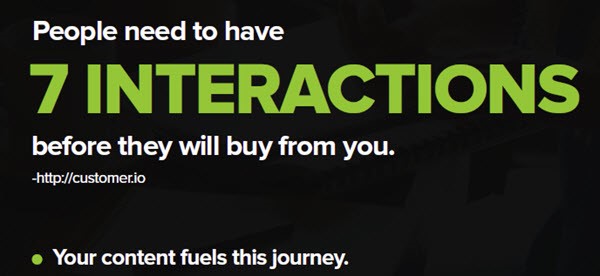Social media opens up a world of possibilities for companies both large and small. From outreach opportunities to marketing potential, a well-executed social media presence has the capability of significantly improving the bottom line of any business while generating new leads and identifying additional sales demographics. However, creating advertisements for social media does differ from more traditional outreach methods, so identifying the very best ways to write marketing content for these websites can help maximize every single advertising dollar spent. To improve social media ad writing and bolster a company’s presence on these growing platforms, here are 10 quick ad-writing tips from social media experts.
1) Keep it Simple
More often than not, the easiest solution is the best. When using a social media platform, users scroll through content until something catches their eye. Long worded posts fail to pass the scrolling eye test. As Emily Copp of Hootsuite (2017) points out, “Whenever possible, simplify your writing. You don’t want to make people work harder than is necessary to engage with your ad.”
In order to directly grab the attention of someone quickly scrolling through his or her news feed, advertising needs to contain as little text as possible. This way, a user can take in the full advertisement without ever stopping to read a long-winded ad. According to Emily, the shorter and simpler the better. She suggests taking out all unnecessary adjectives and swapping in shorter words for longer ones.
According to SJ Insights (2014), an average Internet user is exposed to around 5,000 advertisements on a daily basis. Despite this, very few ads actually stay with a viewer. There are a handful of different reasons as to why that is, but one of the top reasons is the potential consumer doesn’t absorb the advertisement when they see it. Because there are so many ads on a daily basis (which equates to about 3.5 advertisements per minute), an advertisement needs to instantly connect with a consumer. Keeping it simple ensures a possible client at least has the capability of seeing the entire contents of the ad. If the average social media user is unable to take in the general idea of the marketing material while they scroll, the content still needs simplification.
(Source)
2) Social Media Marketing Mission Statement
Every business needs a mission statement. A mission statement clearly identifies why a business exists, the values of the company and how it plans on reaching and establishing these core values. While a centralized mission statement exists, encompassing the entire company, the business should look at creating individualized mission statements for specific projects. This holds true for social media marketing (and all marketing, in general).
According to Joe Pulizzi of the Content Marketing Institute (2012), every marketing campaign requires it’s own specific mission statement as individual marketing approaches focus on different key demographics with varying agendas and desired end goals. By creating a centralized mission statement for individual social media ad campaigns, it becomes far easier to keep all material on task and focused, which in turn improves the monetary investment on advertisements and helps the business avoid frivolous spending.
There are three very important pillars to a company’s social media marketing mission statement. The first pillar is the core audience for the particular marketing campaign. The beauty of social media is its ability to finely tune a very specific target audience. What one demographic responds to another might have no interest in, so clearly establishing the core audience for the marketing campaign is critical. There are many social media tools that can help you discover the core audience.
The second pillar of the social media marketing mission statement is what exactly will the campaign deliver to the target audience? What kind of information will the business share within posts and paid advertisements? Will the campaign focus on specific advice, resources or insights? What connects all of the posts together? Is there a specific form of inspiration that guides the marketing approach? All of these key points need addressing in order to determine what the social media content will deliver to the target audience.
(Source)
Lastly, when formulating a social media ad campaign, the business needs to identify a desired outcome for the marketing material. Is the goal to boost sales, generate leads or expand the company’s social media following? Additionally, what is the desired outcome for the target audience? Is it to make sure they look good on the latest back to school clothing? Perhaps it is to help rejuvenate their lawn or protect their vehicle with new car insurance.
Once a business has addressed the three pillars of a social media marketing mission statement, it needs to make sure everyone connected with the campaign knows what the mission statement is. Having it clearly posted around the office helps ensure not only everyone knows it but is reminded of the information. After exposing everyone in the office to the mission statement, all subsequent social media posts need to pass a litmus test. This helps keep all the advertising material connected and prevents content from straying off, away from the defined goals of the campaign.
3) The Rule of 7
According to Add Week (2016), 99% of consumers will not see an advertisement the first time around. As stated in the previous tip, with 5,000 daily ads appearing throughout the day, focusing in on a single ad the first time through can prove difficult. That is where the “Rule of 7” comes in.
When watching a television program, flipping through a magazine or driving just about anywhere, repetitive advertisements appear. Coca-Cola might have half a dozen different commercials appear during a single sporting event. This has very little to do with the amount of money an enterprise level company such as Coca-Cola, McDonald’s, Ford or others have available for advertising. It has more to do with what psychologists refer to as the “mere exposure effect.”
The mere exposure effect is the idea that the more someone is exposed to a singular idea, the more likely they are to both absorb the information and act on it. In marketing, the mere exposure effect is known as “The Rule of 7.”
The Rule of 7 suggests repeating a single advertisement as many times as possible during a short period of time. This is the real reason why Budweiser doesn’t just invest in a single advertisement during a Major League Baseball game. Once a viewer has absorbed, recognizes and understands an ad, they become more likely to see the ad in other locations. A slogan they saw on television now appears on buses, billboards and in newspapers. These ads might have always been in these locations, it’s just now that the consumer has identified the marketing material; they are now conditioned to see it (Renesselaer Polytechnic Institute, Effects of Unconscious Exposure to Advertisements, 2008).
(Source)
An easier way to explain the theory of “The Rule of 7” is to look at buying a car. Before going out to purchase a certain model vehicle, a driver doesn’t pay too much attention to others driving the same vehicle. However, after the purchase of the vehicle where the owners have conditioned themselves to notice it on a daily basis, they start to see the model far more often while on the road, in parking lots and when driving past dealerships. It all comes down to conditioning.
According to John Stevens, the CEO of Hosting Facts, it is extremely important for companies, regardless of size, to take advantage of this principle when writing ads for social media marketing. In order to fully exploit The Rule of 7, a company needs to not only do what it can to market itself more frequently, but they need to keep the same short, sweet and simple ad campaign in all the content created for a target demographic. In other words, instead of creating three or four different slogans or campaigns for a single demographic on Facebook, all of the ads should include the same slogan and campaign pitch for the individual target audience. This way, the consumers are more likely to see the marketing material, take notice, and eventually, take action.
(Source)
4) Mine Twitter
Twitter offers the ability to quickly send out bursts of information. With the proper utilization of hashtags, a single well-timed and meaningful tweet has the potential to generate followers originating in every corner of the globe. However, beyond producing posts 140 characters at a time, Twitter provides the limitless potential for mining information.
Mark Schaefer of the Social Media Examiner (2017) suggests finding relevant, powerful Twitter handles connected to the same industry. Identifying the power players and influencers within an industry has the ability to provide a follower with a keen eye the ability to capitalize off of what the influencer has to say and share. This is true even if the owner of the Twitter power account doesn’t directly communicate with the smaller business account.
For starters, interacting and posting comments on the power player’s tweets showcases the smaller company’s own Twitter handle. Educated, helpful and even entertaining posts may connect with other followers, which in turn can lead to the smaller account picking up its own followers.
Secondly, and potentially more important (at least when it comes to social media marketing), the influential account instantly provides its own analytical data for someone who knows how to mine it. It is possible to scroll through an influencer’s account and see exactly which posts generate the most responses. Some tweets are re-tweeted more frequently, while others generate more comments. This provides a goldmine for identifying potential Twitter post topics and even content the smaller account can base advertisement material off of.
According to Kissmetrics (2017), taking information from the competition in order to create a company’s own Twitter and social media marketing ads is a seven-step approach.
First, a company needs to follow their competition on Twitter. Second, they need to follow the company’s replies and look at how the influential account responds to those who comment on posts. It might prove possible for the smaller company to slip in a helpful reply into the conversation, which in turn may steal away followers and business. The third step is to analyze the influential account’s followers (using a tool such as Tweepi can help with this). Analyzing the followers helps indicate what posts they are more likely to comment on, not to mention the social media power of these followers.
(Source)
The fourth step is to look at how frequently the power account posts while the fifth step is to see how the company interacts with other social media accounts. The sixth step is to read any blog posts and articles the influential company shares and, finally, the seventh step is to use a tool like Twitter Grader to find out the company’s “Twitter Rank.” The Twitter Rank shows the most used keywords, the most connected external accounts, and most common topics. By taking into consideration all of this information, the smaller competitor can then generate its own Twitter posts and social media advertisements, all by using an influential account’s own data.
5) Secure Brand and Product Names on Social Media
When a company first starts out a seemingly endless task list exists. Checking off one job just seems to bring up a host of more work to do. Towards the top of a company’s Internet, to-do list should include creating a website and building a social media presence. Generating a Twitter handle and Facebook profile begins early on, but there are so many other social media platforms a company needs to look into.
Some businesses put off identifying and creating brand and product names on social media. The company may not have finished a particular product or be ready to launch just yet. While waiting on grabbing these domains and social media accounts does have some logic, the problem behind this, as Justin Levy, the strategic advisor for social media activities at Citrix Online and the editor-in-chief at Workshifting points out, is another business may gobble up the desired handles and domains. This can cause some confusion with customers as they try and search out the company’s online presence.
Creating social media handles doesn’t take much time. Signing up for services like Pinterest, Instagram, Snapchat, SlideShare and others is a synch and can be done in a matter of minutes. Even if a business isn’t ready to take advantage of a particular social media platform (or if it even knows whether or not it wants to use the platform in the first place), securing these domains and handles is key.
Avoiding confusion with customers is a must. If a company’s Facebook profile is different from it’s Twitter handle or Pinterest account name (perhaps one uses a “the” in the title, while the other platforms include numbers or an LLC indicator), it makes it a little bit more challenging to track down the different ways of following a company.
By securing all of the different social networking handles and platforms early on, it helps later on down the road when creating the social media marketing material. An easy way to search all social media services for available usernames and domains is KnowEm. This service scans 550 different social media networks in order to identify what is available and what sort of variants a company might want to consider instead.
6) Write the Format
Social media formats vary drastically. Facebook allows posts of any length, while Twitter uses a cap of 140 characters. Pinterest has a limit to total characters used, but for an optimal re-pins, the description should only use about half as many of the allotted characters. One of the most important tips the marketing department can take advantage of when writing social media advertisements is to take into account the very specific format and write the ad accordingly.
What is the ideal length for every social media post? Dominique Jackson of Sprout Social (2017) has the answer to that all-important question.
(Source)
When producing content for Facebook, posts, ad copy and anything else appearing on a user’s board with 40 characters or fewer experiences an 86 percent higher engagement level. This number increases to 88 percent for posts of around 80 characters. However, anything more than this and the longer post begins to see a drastic engagement drop off. So, Facebook ad copy needs to remain between 40 and 80 characters.
But what about the length of an advertisement headline on Facebook? Should this vary from a promotional post on Facebook? Yes. According to research conducted by Adspresso (2015), the service looked at a total of 37,000 Facebook advertisements and found the most popular posts by far had five words in the headline. Following the optimal length of the title, the body of a Facebook ad should have 14 words and the description should contain 18 words.
Facebook provides a few different advertisement opportunities. One of these marketing methods includes a Facebook Lead Generation Ad, which is a bit different from a canvas ad or image ad. The Lead Generation ad does vary from the other options, as it requires more in way of descriptive information. When using these posts, the desired context card headline should be 45 words, the benefits text should include five bullet points of 80 characters each, the button text should consist of 25 characters, the custom question text should sit at 50 characters, the privacy policy link text should be around 100 characters, and the custom disclaimer title should include 60 characters.
Twitter allows for up to 140 characters, but this doesn’t mean the optimal length consists of the entire 140 allotted figures. Tweets with 100 characters receive a 17 percent higher engagement level than longer tweets. Promoting on Twitter can prove a bit more challenging due to the sheer number of tweets (both promoted and ordinary) on a user’s feed. Due to this, the shorter tweets of around 100 characters are highlighted with a larger font, which instantly increases visibility.
Advertising on Instagram opens up a world of possibilities, especially for visual-based companies. While the quality of the image stands out above anything else, understanding optimal caption length here is important as well. Ad captions should hit 125 characters. This will ensure the entire caption appears completely on smaller screens. Additionally, while there is no real “limit” to the number of hashtags placed on an Instagram image, it is important to not go overboard. Posting too many hashtags onto a single image on Instagram may lead to what is known as a “shadow ban.” This occurs when a post no longer appears in certain keyword searches due to hashtag stuffing. In order to avoid this, the ideal number of #hastags placed onto a single image is around five and 10. On top of this, hashtags should not be more than 24 characters. Anything longer than this and engagement drops off with the image.
When marketing and posting on LinkedIn there isn’t a necessary character length. However, status updates of between 50 and 100 characters receive the most traffic and attention.
Pinterest allows for pin and board descriptions. These descriptions allow a company to provide more insights regarding the information within a single pin and what a general board covers. While each of these character limits sit at 500 characters, the optimal length for each should hit between 200 and 300 figures.
Marketing and creating advertisements for social media platforms can prove a bit tricky, simply because every platform offers something a little bit different and has varying guidelines. Optimizing the post for each account helps boost engagement from viewers by standing out and generating more attention, so understanding how to write for a specific format is critical. As Dominique Jackson points out, following these specific guidelines should help.
7) Analyze Past Content
Mining the accounts of power influencers within a company’s given industry can provide valuable insights into what the emerging business should do in terms of its own social media ad writing. However, it can also look towards its own past content in order to identify possible marketing posts.
By looking at previous posts, a company can find what content has proven the most successful with its current followers. Naturally, scrolling through years worth of social media does not offer an optimal use of time. Due to this, Neal Schaffer of Maximize Your Social recommends using a service such as BuzzSumo.
BuzzSumo allows a user to type in a keyword that they want to use within their upcoming social media advertisement. BuzzSumo will not only look at how this particular keyword has been used successfully in the past by the user but also how top performers user the keyword as well. This way, a user has the ability to compare their own past social posts with the competition and major influencers. This information should prove especially enlightening when writing out the best social media advertisements for all platforms.
According to Neal Schaffer, using BuzzSumo in order to curate the very best social media content uses a five-step process. The first is to compare the current power players (or “role models” as he refers to the companies as). The second step is to look to the company’s own audience preference for potential ideas based on the number of shares and likes. The third step is to create content. When creating content, the emerging business should post (share) the “Role Model’s” content nine times, then add a single post designed to add value to the shared material, followed by a promotional post. This way, when another users see the social media advertisement and engage with it, they arrive on a professional profile with a host of beneficial information. This is a crucial step far too many companies forget to carry out. Without exceptional content already in place on the account, anyone who interacts with the social media ad may not remain, follow the user or look further into services and products offered simply due to the lack of quality content on the company’s page.
(Source)
The fourth step is to connect with the influencer and the fifth step is to take full advantage of advertisements in order to help grow the company’s social audience. By taking advantage of these five steps, a growing company can quickly establish itself as an up and coming power player within the industry.
8) Build Social Trust
Developing a connection with current platform followers stands as an essential pillar to not only growing a company’s social media presence but for ensuring the highest level of return on marketing. Should an interested user click on an advertisement and arrive on a company’s Facebook page, they are looking for a few different specifics. One, their curiosity for particular products or services was peaked, which is why they are there, so providing information on these services is a must. Second, the potential customer wants to see a healthy interaction between company and follower. If they see followers are neglected, their comments are not replied to or a lack of any genuine interaction at all, they become less likely to become active followers themselves. According to John Jantsch of Duct Tape Marketing, it is vital for a company to build social trust with its followers.
John Jantsch goes into detail about how to build social trust and breaks it down into seven important steps. The first is to simply listen. Listening to what a customer has to say provides instant market research. It demonstrates how a person feels, what they’re interested in and what might make current products and services better.
The second step is to populate a social media account with what people in the target demographic are looking for. When using a search engine, what are common questions people ask in relation to a company’s services? Basing social posts on these insights helps instantly make an account more desirable to a visitor.
The third step in building social trust is to look at social media like real estate. The more properties a company has up and running the better. So optimizing content for Facebook, YouTube, Slideshare, LinkedIn, and others spread potential outreach and makes it easier for a consumer to approach (some people are more likely to connect through LinkedIn while others prefer YouTube).
The fourth step is to “see awareness.” A customer is not going to purchase a product or service until they are aware of what a company offers. So before a company should start marketing and actively selling what it has to offer, it needs to make followers aware of what it has to offer.
Step five is networking. Networking remains an important step in improving how a company stands out. From connecting with influential power players on Facebook to claiming a business through the local Chamber of Commerce, networking must remain a continual activity for a business.
Step six is to take it offline. Connecting with customers through social posts and social media advertisements allow for offline connections as well. Even though social media is an important step, a large number of sales occur on the phone, while at a desk or in person. Some of these relationships just begin through social media. By using social media advertisements to build trust and generate leads, it is possible to then connect on an offline, more direct level.
The last step in developing social trust is to look towards the system as a solution. Essentially, a business is a series of systems running together. Marketing and social media marketing are individual systems. Using these different social media platforms as scheduled systems build social trust. So while it may feel odd setting out to tweet a certain number of messages a day or commenting on blogs and interacting with customers who post under an ad, it is all part of the social trust and social media marketing building systems.
9) Test Emojis
To some, the use of emojis may seem a bit juvenile. After all, is there really a need to add on a smiley face or a thumbs up to a social media message? In a way, the use of these animated icons is somewhat childish. However, it also helps put a literal friendly face on a large company (there’s a reason why Wal-Mart used a gliding smiley face in advertisements for years). According to Aleh Barysevich of Social Media Today (2017), companies need to take advantage of emojis in social media marketing.
(Source)
Just how beneficial can the use of emojis in social media advertising be? As the research conducted by Appboy (2016) points out, emoji-based marketing campaigns boost ad results nearly across the board. On Twitter, including emojis improves engagement by 25.4 percent. On Facebook, it boosts likes by 57 percent, comments by 33 percent, and shares by 33 percent. Additionally, it helps improve Instagram recognition by nearly 50 percent. Plus, emojis only use a single character, which makes it an extremely beneficial use of prime character real estate within these different platforms.
10) Test and Revise
This is a social media ad-writing tip offered by nearly all expert marketers out there. It is crucial to continually look into how current and past marketing campaigns have worked. What generated the most interest, what saw the greatest level of response and what ads just simply didn’t work at all? From there, it is possible to identify ways to tinker and edit a marketing campaign for future use. Learning from the past, while taking into account the other previous nine expert tips makes it possible to continually reinvent how a company reaches out to potential customers through social media.
Fred Thompson of New Destiny Media (2016) says one of the most important steps any company can carry out, regardless of industry, is to “test, review and revise.” Social media platforms are fast moving, so it takes continual analysis to find ways to stay fresh and improve connections with new and current followers alike. Social media, above nearly all other marketing avenues, goes stale quickly, so staying on top of the latest changes ensures a company can always move forward with the latest and best content possible.
(Source)
In Conclusion
Social media marketing provides a business with a world of opportunities. From growing its following base and identifying new leads to boosting sales and improving the company’s bottom line. However, writing ad copy for social media platforms differs greatly not only from other forms of advertising but between each platform. By taking advantage of these 10 quick social media ad-writing tips from the experts, it is possible to maximize a company’s marketing effort. It just takes a little bit of research and understanding of individual platforms to fully take advantage of the opportunities presented by social media.












